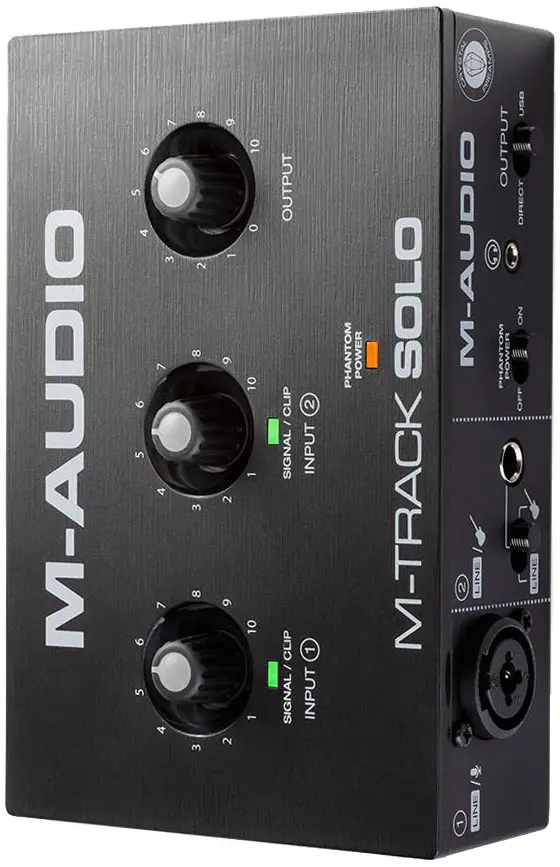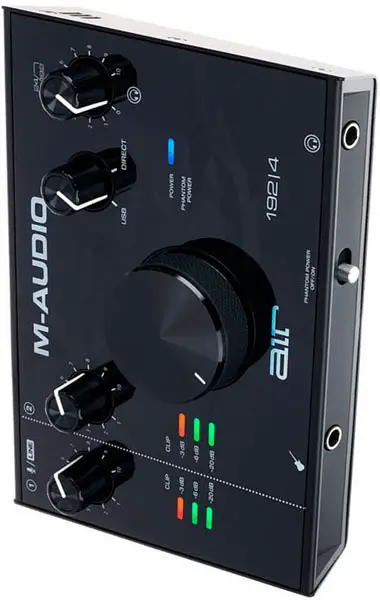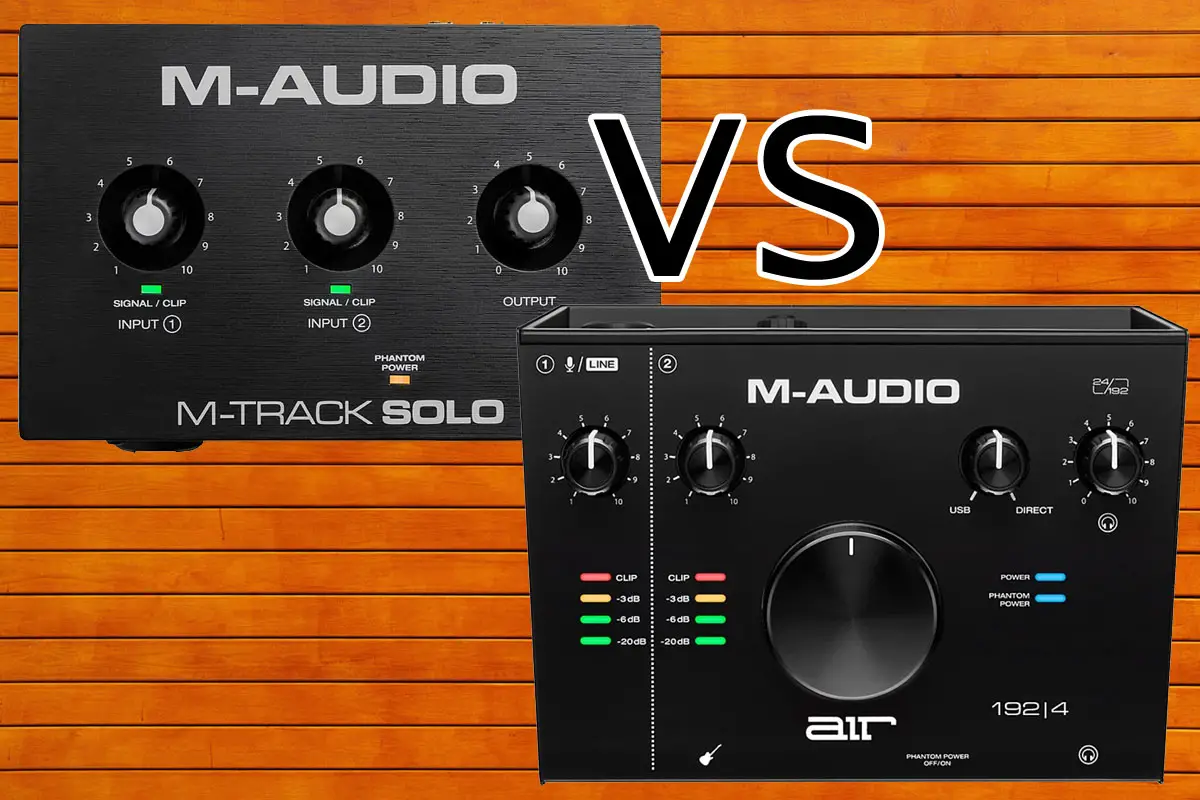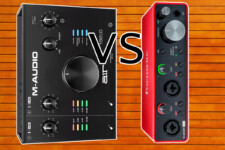M-Audio M-Track Solo vs M-Audio Air 192|4 : Which Audio Interface Is Better for Your Home Studio?
If you are looking for an affordable and easy-to-use audio interface for your home studio, you might be interested in two great products from M-Audio: the M-Track Solo and the Air. Both of these devices are designed to offer high-quality audio recording and playback, but they have some differences that might make one more suitable for your needs than the other.
The M-Track Solo is a 2-in/2-out audio interface that offers decent sound quality, low latency, and a simple interface. The M-Audio Air 192|4 is a 2-in/2-out audio interface that features switchable Air mode that gives your recordings a brighter and more open sound. Both of these devices are USB-powered and compatible with most DAWs and operating systems.
In this article, we will compare the features, performance, and price of these two audio interfaces, and help you decide which one is the best choice for you.

A Quick Look
If you want a cheap and simple audio interface that can handle basic recording and playback tasks, you may want to choose the M-Audio M-Track Solo. It has a USB-C to USB-A cable that can work with any device with a USB port. It also has low latency, ASIO drivers, and a software bundle that includes Pro Tools First M-Audio Edition and other plugins.
If you want a high-quality and versatile audio interface that can capture more details and dynamics in your sound, you may want to choose the M-Audio Air 192|4. It has a switchable Air mode that gives your recordings a brighter and more open sound. It also has a comprehensive software bundle that can help you enhance your music production.

M-Audio M-Track Solo
- Mobile-ready, bus-powered, 2-in/2-out USB.
- Record at up to 16-bit/48kHz resolution.
- Zero-latency direct monitoring with a dedicated knob.
- One XLR mic input.
- One 1/4″ switchable instrument/line input that allows you to connect different types of sources to the interface.
- Two Line RCA outputs.
- Crystal preamp provides transparent and low-noise sound quality.
- 48V phantom power for condenser microphones.
- Great value for money, excellent beginner option.

M-Audio Air 192|4
- Mobile-ready, bus-powered, 2-in/2-out USB-C.
- Record at up to 24-bit/192kHz resolution.
- One combo mic/line/instrument input with switchable Air mode.
- One TRS input for instrument or line-level signal.
- Two balanced 1/4-inch TRS outputs.
- 48V phantom power for condenser microphones.
- Direct monitoring switch with mix knob.
- Gain controls with LED indicators.
Price Comparison
The M-Audio M-Track Solo is cheaper than the M-Audio Air 192|4, as you might expect from its fewer features and lower resolution. The M-Audio M-Track Solo has a recommended retail price of $49, but you can find it online for around $40. The M-Audio Air 192|4 has a higher price tag of $119, but it also offers higher audio quality and more inputs and outputs.
So, the price difference between the M-Audio M-Track Solo and the M-Audio Air 192|4 is quite significant, depending on what you need from an audio interface. If you are looking for a simple and affordable interface for recording vocals or instruments, you might prefer the M-Audio M-Track Solo. If you are looking for a more advanced and versatile interface for professional recording and monitoring, you might prefer the M-Audio Air 192|4.
Common Features
Both the M-Track Solo and the Air 192|4 have some common features that make them suitable for basic recording and playback tasks. Here are some of them:
- XLR/TRS combo input: Both devices have one XLR/TRS combo input that can accept either a microphone or an instrument cable. This allows you to record vocals, guitars, keyboards, or any other mono source with ease.
- TRS input: Both devices also have a separate TRS input that can accept either an instrument or a line-level signal. This gives you more flexibility to record stereo sources or connect external devices such as synths or drum machines.
- Phantom power: Both devices can provide 48V phantom power to the XLR input, which is essential for using condenser microphones that require external power.
- Headphone output: Both devices have a 1/4-inch headphone output that lets you monitor your sound with headphones. This is useful for avoiding feedback or noise from speakers when recording.
- Direct monitoring: Both devices have a switch that lets you choose between direct monitoring and USB monitoring. Direct monitoring allows you to hear your input signal without any latency or processing from your computer. USB monitoring allows you to hear your input signal mixed with the playback from your DAW or other software.
- Gain controls: Both devices have rotary knobs that let you adjust the gain level of each input channel. They also have LED indicators that show you when your signal is clipping or too low.
- Master volume control: Both devices have a rotary knob that lets you adjust the overall output volume of the device. This affects both the TRS outputs and the headphone output.
M-Audio M-Track Solo – Unique Features
- Unbalanced RCA outputs: These are outputs that use RCA connectors, which are common in consumer audio equipment. However, they are more prone to interference and noise than balanced outputs.
- ASIO drivers: These are drivers that allow low-latency and high-performance audio processing on Windows computers.
M-Audio Air 192|4 – Unique Features
- Switchable Air mode: This is a feature that gives your recordings a brighter and more open sound by adding some high-frequency enhancement. This can be useful for adding some sparkle and clarity to your vocals or acoustic instruments, or for creating some contrast and depth in your mix.
- Balanced TRS outputs: These are outputs that use TRS connectors, which are common in professional audio equipment. They offer a cleaner and louder signal than unbalanced outputs by canceling out noise and interference.
Sound Quality Comparison
Sound quality is one of the most important criteria when evaluating an audio interface. After all, you want your recordings to sound as good as possible, right? Well, both the M-Track Solo and the Air claim to offer high-quality sound, but there are some differences in their specifications and performance.
The M-Track Solo has a bit depth of 16-bit and a sample rate of 48 kHz. This means that it can capture and reproduce up to 65,536 levels of amplitude and up to 24 kHz of frequency in digital audio. This is technically enough to cover the human hearing range, but it is not very impressive compared to other audio interfaces on the market that offer 24-bit or higher bit depth and 96 kHz or higher sample rate.
The Air 192|4 has a bit depth of 24-bit and a sample rate of 192 kHz. This means that it can capture and reproduce up to 16,777,216 levels of amplitude and up to 96 kHz of frequency in digital audio. This is much more detailed and accurate than the M-Track Solo, and it allows you to capture more nuances and dynamics in your sound.
Another difference between these two audio interfaces is their Air mode. The M-Track Solo does not have this feature, while the Air has a switch that lets you activate it on the XLR input. Air mode is a feature that gives your recordings a brighter and more open sound by adding some high-frequency enhancement. This can be useful for adding some sparkle and clarity to your vocals or acoustic instruments, or for creating some contrast and depth in your mix.
The sound quality of these two audio interfaces also depends on other factors, such as the quality of your microphone, instrument, cables, speakers, headphones, and software. However, based on their specifications and reviews, it seems that the Air 192|4 has a clear advantage over the M-Track Solo in terms of sound quality.
Compatibility
Another aspect that you might want to consider when choosing an audio interface is its compatibility with your computer, operating system, and software. You want an audio interface that works smoothly with your setup and does not cause any issues or conflicts.
The M-Track Solo is a class-compliant device, which means that it does not require any drivers to work with most operating systems and software. It is compatible with Windows 7 or higher, Mac OS X 10.8 or higher, iOS 9 or higher, and Android 5.0 or higher. It also comes with a USB-C to USB-A cable that lets you connect it to any USB port on your computer or mobile device.
The Air 192|4 is also a class-compliant device, but it requires a software application called M-Audio Control Panel to access some of its features and settings. It is compatible with Windows 7 or higher, Mac OS X 10.8 or higher, iOS 9 or higher, and Android 5.0 or higher. It also comes with a USB-C to USB-A cable that lets you connect it to any USB port on your computer or mobile device.
Both of these audio interfaces are compatible with most DAWs and other audio software, such as Pro Tools, Logic Pro, Ableton Live, GarageBand, Audacity, Reaper, FL Studio, Cubase, and more.
M-Track Solo Pros
- Very affordable.
- Easy to use.
- Low latency.
- Class-compliant.
- Compatible with most operating systems and software.
M-Track Solo Cons
- Low bit depth and sample rate.
- No Air mode.
- No MIDI input/output.
- No level meter.
M-Audio Air 192|4 Pros
- High bit depth and sample rate.
- Switchable Air mode that gives recordings a brighter and more open sound
- Class-compliant.
- Compatible with most operating systems and software.
M-Audio Air 192|4 Cons
- More Expensive.
- Requires M-Audio Control Panel software.
- No MIDI input/output.
Which One Would You Choose?
As you can see, both the M-Track Solo and the Air 192|4 have their strengths and weaknesses. The best choice for you depends on your budget, preferences, and needs.
If you are looking for a cheap and simple audio interface that can handle basic recording and playback tasks, you might want to go for the M-Track Solo. It offers decent sound quality, low latency, and a simple interface that does not require any drivers or software. It also comes with a generous software bundle that can help you get started with your music production.
If you are looking for a high-quality and versatile audio interface that can capture more details and dynamics in your sound, you might want to go for the Air 192|4. It offers superior sound quality, switchable Air mode that adds some sparkle and clarity to your sound. It also comes with a comprehensive software bundle that can help you enhance your music production.
Both of these audio interfaces are capable of delivering good results for beginners and hobbyists who want to record their music at home. However, if you want to take your sound quality to the next level, you might want to invest in the Air 192|4.




